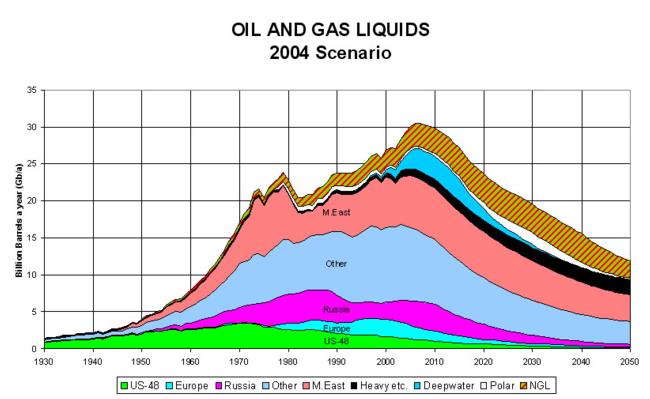
Gene Cooperman
This is structured as an overview, followed by a table of contents at
the end of this web page.
For links to other sources of information, see
http://www.ccs.neu.edu/home/gene/peakoil/peakoil-links.html.

Today, there is a strong debate over when the peak in oil production will come: either in the next five years; or beyond the year 2030. Since the true state of affairs will have severe consequences for economic growth, the discrepancy is worth studying.
This is sometimes painted as a debate between a group of petroleum geologists [10,11,13] (peak in the next five years), and a group of economists [16,19] (peak beyond 2030). The geologists argue that the oil in the ground is finite. The very low rate of new oil discoveries since 1990 foretells that peak oil production will be reached in the next five years. The ``end'' will not be a sharp drop-off, but a plateau followed by decreasing oil production. This rise, plateau and falloff in production forms a bell curve, commonly called the Hubbert curve. In the 1950s, M.K. Hubbert correctly predicted that the United States would reach its peak oil production a little over a decade later, in the early 1970s. When Hubbert's approach is applied to the world, it predicts a peak in the next five years. This approach is discussed in detail in Section 2.5 (Technical Note: the Hubbert Model).
The economists counter that the laws of supply and demand will operate even for our non-renewable oil resources. They argue that as prices rise, we will both search harder in order to raise the rate of oil discovery, and we will raise recovery rates to extract more of the existing oil. The demand for oil as gasoline is relatively inelastic. Hence, the economists predict that higher prices will bring higher oil production, bringing supply back into balance with demand. (At least, supply and demand will be in balance through 2030, according to forecasts by the EIA and IEA.)
The economists' view is represented by the Energy Information Agency (EIA) of the United States and the International Energy Agency (IEA) of the industrialized nations. They argue that the peak will not arrive before 2030, and maybe much later. They base their arguments on the World Petroleum Assessment of the U.S. Geological Service (USGS) from the year 2000. That assessment is in turn based on the raw data of the U.S. Geological Survey from 1996. The 1996 survey assessed how much oil remains in the ground to be discovered. The 2000 assessment additionally assessed how much additional oil is to be recovered from existing fields through new technology and reassessments of the size of existing oil fields. Current oil price projections are also taken into account, to yield projections for a reference case, and for a high and low price case.
Enough data from around the world now exists to show that the U.S. Geological Survey predictions from 1996 and 2000 are widely off course. The discrepancies are especially obvious for certain countries, like Indonesia. Based on estimated undiscovered oil, the EIA projects production of 1.5 million barrels per day from 1990 to 2025 for Indonesia. Yet current production in Indonesia is less than 1 million barrels per day, and is decreasing at approximately 10% per year. Consequently, the petroleum geologists have been predicting continuing declining production, based on the absence of significant new oil discoveries in Indonesia. Similar discrepancies hold for projections for the United States (flat versus declining production), the former Soviet Union (doubling of production versus flat production), etc. (See a comparison of the original statistics.)
The greatest controversy surrounds Saudi Arabia. The EIA predicts a doubling from 10% of world oil production today to almost 20% in 2025. The petroleum geologists accept that Saudi Arabia has potential for some limited increased production, but much less than double. Even the Saudis do not endorse the EIA estimate. Saudi Arabia previously reached its peak oil production of 9.9 million barrels per day in 1980.
The petroleum geologists strongly dispute that Saudi oil production can be doubled in the next 20 years. They base this on current production levels, the age of Saudi Arabia's currently producing oil fields, and hints of growing oil depletion found in scholarly oil journal articles by Saudi Aramco. Specifically, the last discovery of a super-giant oil field occurred 35 years ago [1], and most of current Saudi oil production is from oil fields discovered 50 years ago.
Because the national oil company, Saudi Aramco, is a private company owned by the Saudi royal family, there is a lack of public data concerning Saudi oil fields. However, Saudi official statements speak only of an increase of 20% production in the medium term, and 50% production in the long term. They do not talk of a doubling of oil production. Some high former Saudi Aramco officials have gone on record to actively disagree with the EIA and IEA estimates [ 5, Channel4News].
This report is in three sections. Section 1 demonstrates that Peak Oil is already here in the ``rest of the world'' (excluding OPEC and the former Soviet Union). Section 2 provides a prognosis for future oil production and the arrival of peak oil. Section 3 considers the prospects for various alternative energy sources. Last, but not least, is the References section. No one should ever accept an argument without being able to check the underlying facts.